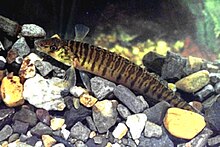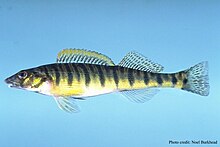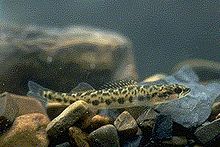Real perch
| Real perch | ||||||||||||
|---|---|---|---|---|---|---|---|---|---|---|---|---|
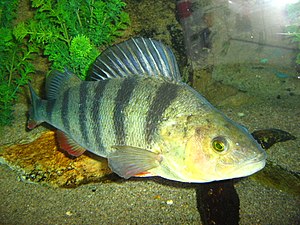
Perch ( Perca fluviatilis ) |
||||||||||||
| Systematics | ||||||||||||
|
||||||||||||
| Scientific name | ||||||||||||
| Percidae | ||||||||||||
| Cuvier , 1816 |
The real perch (Percidae, Gr .: perke = perch) are a family from the order of the perch-like (Perciformes). The animals inhabit fresh waters all over the northern hemisphere. Sometimes they penetrate into brackish water , e.g. B. in the Baltic Sea . European species are u. a. the perch ( Perca fluviatilis ), the Kaulbarsch ( Gymnocephalus cernuus ) which Zander ( Sander lucioperca ) and the Streber ( Zingel streber ).
features
The largest species, the European pikeperch ( Sander lucioperca ), grows to 130 cm long, while most species of the subfamily Etheostomatinae do not even reach ten centimeters (these are benthic , spindle-shaped and have a reduced or no swim bladder). The smallest species, Etheostoma denoncourti , is only 2.9 cm long. All real perch feed carnivorously on invertebrates or smaller fish.
Real perch always have two dorsal fins that are clearly separated or that can touch. The first is supported by spiked rays, the second by soft rays. The anal fin usually has two, more rarely one spine. The second is always poorly developed. The paired, chest-like pelvic fins have one hard and five soft rays. The real perch have strong comb scales . The premaxillary can be extended, the supramaxillary is absent. The number of Branchiostegal rays is five to eight. The pseudobranchs are mostly free and well developed, rarely rudimentary.
Way of life
Real perch can be territorial loners, but schooling fish also occur in the family. All carnivorous feed on aquatic insects, worms, crustaceans and fish spawn. Large species like the pikeperch are piscivorous predatory fish. The fish release their spawn into the open water, between plants, in pits in the ground, or attach them to a solid substrate. Brood care by the male occurs, e.g. B. in the jumping bass .
Systematics
External system
The real perch belong to the subordination of the Percoidei within the order of the perch-like (Perciformes). Both taxa were traditionally polyphyletic , but were replaced by R. Betancur-R. and colleagues very much narrower and thus to ( monophyletic ) clades . The closest relatives of the real perch are the weever and Niphon spinosus .
Internal system
The family is divided into three subfamilies and ten genera. There are over 220 species , 14 of which live in temperate Eurasia and more than 200 in North America east of the Rocky Mountains . Over 130 species belong to the North American jumping bass ( Etheostoma ).
Subfamily Percinae
In the subfamily Percinae, the body is laterally flattened, the anterior interhema bone (the foremost supporting bone of the anal fin, which also closes the body cavity at the back) is greatly enlarged, the spines of the anal fin are well developed. The gill covers are strongly serrated. Usually the Percinae have 7 to 8 Branchiostegalray rays . The swim bladder is well developed. Without spawning rash .
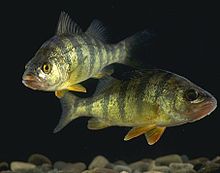
- Genus Gymnocephalus Bloch, 1793
- Don ruff ( Gymnocephalus acerina ) (Güldenstädt, 1774)
- Ammersee ruff ( Gymnocephalus ambriaelacus ) Geiger & Schliewen, 2010
- Danube rump ( Gymnocephalus baloni ) Holcík & Hensel, 1974
- Ruff ( Gymnocephalus cernua ) (Linnaeus, 1758)
- Schrätzer ( Gymnocephalus schraetser ) (Linnaeus, 1758)
- Genus Perca Linnaeus, 1758
- American perch ( Perca flavescens ) (Mitchill, 1814)
- Common perch ( Perca fluviatilis ) Linnaeus, 1758
- Balkhash perch ( Perca schrenkii ) Kessler, 1874
- Genus Percarina Nordmann, 1840
- Percarina demidoffii Nordmann, 1840
- Percarina maeotica Kuznetsov 1888
Subfamily Luciopercinae

In the subfamily Luciopercinae, the body is spindle-shaped. The interhemal bone in front is no larger than the one behind it. The fin spines of the anal fin are small. The sideline extends to the caudal fin. Without spawning rash.
- Genus Sander Oken, 1817
- Genus Romanichthys Dumitrescu, Bănărescu & Stoica, 1957
- Bullhead perch ( Romanichthys valsanicola ) Dumitrescu, Bănărescu & Stoica, 1957
- Genus Corkfish ( Zingel ) Cloquet, 1817
Subfamily Etheostomatinae
In the subfamily Etheostomatinae, also known as bottom perch in German, the body is spindle-shaped or slightly flattened on the sides. The interhemal bone lying in front is greatly enlarged, the fin spines of the anal fin are well developed, the edge of the gill cover is smooth or only partially toothed, usually 5 or 6 Branchiostegaljays, swim bladder reduced or absent. With spawning rash.
- Genus Ammocrypta Jordan, 1877
- Ammocrypta beanii Jordan, 1877
- Ammocrypta bifascia Williams, 1975
- Ammocrypta Clara Jordan & Meek, 1885
- Ammocrypta pellucida (Putnam, 1863)
- Ammocrypt vivax Hay, 1882
- Genus Crystallaria Jordan & Gilbert in Jordan, 1885
- Crystallaria asprella (Jordan, 1878)
- Crystallaria cincotta (Welsh and Wood, 2008)
- Genus jumping bass ( Etheostoma ) Rafinesque, 1819
- Genus Percina Haldeman, 1842
- Percina antesella Williams & Etnier, 1977
- Percina apina Near et al., 2017
- Percina aurantiaca (Cope, 1868)
- Percina aurolineata Suttkus & Ramsey, 1967
- Percina aurora Suttkus & Thompson in Suttkus, Thompson & Bart, 1994
- Percina austroperca Thompson, 1995
- Percina brevicauda Suttkus & Bart in Suttkus, Thompson & Bart, 1994
- Percina brucethompsoni Robison, Cashner, Raley & Near, 2014
- Percina burtoni Fowler, 1945
- Percina caprodes (Rafinesque, 1818)
- Percina carbonaria (Baird & Girard, 1853)
- Percina copelandi (Jordan, 1877)
- Percina crassa (Jordan & Brayton, 1878)
- Percina crypt Freeman, Freeman & Burkhead, 2008
- Percina cymatotaenia (Gilbert & Meek in Gilbert, 1887)
- Percina evides (Jordan & Copeland in Jordan, 1877)
- Percina gymnocephala Beckham, 1980
- Percina jenkinsi Thompson, 1985
- Percina kathae Thompson, 1997
- Percina lenticula Richards & Knapp, 1964
- Percina macrocephala (Cope, 1867)
- Percina macrolepida Stevenson, 1971
- Percina maculata (Girard, 1859)
- Percina nasuta (Bailey, 1941)
- Percina nigrofasciata (Agassiz, 1854)
- Percina notogramma (Raney & Hubbs, 1948)
- Percina oxyrhynchus (Hubbs & Raney, 1939)
- Percina palmaris (Bailey, 1940)
- Percina pantherina (Moore & Reeves, 1955)
- Percina peltata (Stauffer in Cope, 1864)
- Percina phoxocephala (Nelson, 1876)
- Percina rex (Jordan & Evermann in Jordan, 1889)
- Percina roanoka (Jordan & Jenkins in Jordan, 1889)
- Percina sciera (Swain, 1883)
- Percina shumardi (Girard, 1859)
- Percina squamata (Gilbert & Swain in Gilbert, 1887)
- Percina stictogaster Burr & Page, 1993
- Percina suttkusi Thompson, 1997
- Percina tanasi Etnier, 1976
- Percina uranidea (Jordan & Gilbert in Gilbert, 1887)
- Percina vigil (Hay, 1882)
Tribal history
The Percidae and the genus Perca have been fossilized since the Eocene from North America, Europe and western Asia. The genus Dules became extinct from the middle Eocene of Europe.
Remarks
- ↑ According to Pape 1880, πέρκη is related to περκνός "gray (blue), dark". But since there are passages and even word explanations for περκνός as ποικιλός “multicolored, colorful” (and Pape thinks the perch mentioned by Aristotle is “gray-blue”!), It is better not to follow Pape here - you can then also interpret the trout as a diminutive of forche as "colorful" fish (see Wiktionary: "trout"). So, despite its similarity to perca , perch has nothing to do with etymology.
swell
literature
- Joseph S. Nelson : Fishes of the World . John Wiley & Sons, 2006, ISBN 0-471-25031-7 .
- Kurt Fiedler: Textbook of Special Zoology . 2nd volume. 2nd part: fish . Gustav Fischer Verlag, Jena 1991, ISBN 3-334-00339-6 .
- Karl Albert Frickhinger: Fossils Atlas Fishes . Mergus Verlag, Melle 1999, ISBN 3-88244-018-X .
Individual evidence
- ↑ Etheostoma denoncourti on Fishbase.org (English)
- ↑ Ricardo Betancur-R, Edward O. Wiley, Gloria Arratia, Arturo Acero, Nicolas Bailly, Masaki Miya, Guillaume Lecointre and Guillermo Ortí: Phylogenetic classification of bony fishes . BMC Evolutionary Biology, BMC series - July 2017, DOI: 10.1186 / s12862-017-0958-3
- ↑ Stuart A. Welsh, Robert M. Wood: Crystallaria cincotta, a new species of darter (Teleostei: Percidae) from the Elk River of the Ohio River drainage, West Virginia . In: Magnolia Press (ed.): Zootaxa . No. 1680, Jan 14, 2008, pp. 62-68.
- ↑ Stuart A. Welsh, Robert M. Wood, Kenneth R. Sheehan: Threatened fishes of the world: Crystallaria cincotta Welsh and Wood 2008 (Percidae) . In: Environmental Biology of Fishes . tape 84 , no. 2 , January 2009, ISSN 0378-1909 , p. 191-192 , doi : 10.1007 / s10641-008-9405-z .
Web links
- Real perch on Fishbase.org (English)

